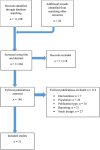The effectiveness and safety of proton beam radiation therapy in children and young adults with Central Nervous System (CNS) tumours: a systematic review
- PMID: 38294638
- PMCID: PMC10978619
- DOI: 10.1007/s11060-023-04510-4
The effectiveness and safety of proton beam radiation therapy in children and young adults with Central Nervous System (CNS) tumours: a systematic review
Erratum in
-
Correction to: The effectiveness and safety of proton beam radiation therapy in children and young adults with Central Nervous System (CNS) tumours: a systematic review.J Neurooncol. 2024 Mar;167(1):35-37. doi: 10.1007/s11060-024-04612-7. J Neurooncol. 2024. PMID: 38441841 Free PMC article. No abstract available.
Abstract
Background: Central nervous system (CNS) tumours account for around 25% of childhood neoplasms. With multi-modal therapy, 5-year survival is at around 75% in the UK. Conventional photon radiotherapy has made significant contributions to survival, but can be associated with long-term side effects. Proton beam radiotherapy (PBT) reduces the volume of irradiated tissue outside the tumour target volume which may potentially reduce toxicity. Our aim was to assess the effectiveness and safety of PBT and make recommendations for future research for this evolving treatment.
Methods: A systematic review assessing the effects of PBT for treating CNS tumours in children/young adults was undertaken using methods recommended by Cochrane and reported using PRISMA guidelines. Any study design was included where clinical and toxicity outcomes were reported. Searches were to May 2021, with a narrative synthesis employed.
Results: Thirty-one case series studies involving 1731 patients from 10 PBT centres were included. Eleven studies involved children with medulloblastoma / primitive neuroectodermal tumours (n = 712), five ependymoma (n = 398), four atypical teratoid/rhabdoid tumour (n = 72), six craniopharyngioma (n = 272), three low-grade gliomas (n = 233), one germ cell tumours (n = 22) and one pineoblastoma (n = 22). Clinical outcomes were the most frequently reported with overall survival values ranging from 100 to 28% depending on the tumour type. Endocrine outcomes were the most frequently reported toxicity outcomes with quality of life the least reported.
Conclusions: This review highlights areas of uncertainty in this research area. A well-defined, well-funded research agenda is needed to best maximise the potential of PBT.
Systematic review registration: PROSPERO-CRD42016036802.
Keywords: Brain; CNS tumours; Children; Photon beam; Proton beam radiotherapy; Systematic review.
© 2024. The Author(s).
Conflict of interest statement
The authors declare no competing interests.
All authors declare that they have no conflicts of interest.
Figures
References
-
- Lee CT, Bilton SD, Famiglietti RM, Riley BA, Mahajan A, Chang EL, et al. Treatment planning with protons for pediatric retinoblastoma, medulloblastoma, and pelvic sarcoma: how do protons compare with other conformal techniques? Int J Radiat Oncol Biol Phys. 2005;63:362–372. doi: 10.1016/j.ijrobp.2005.01.060. - DOI - PubMed
Publication types
MeSH terms
Grants and funding
LinkOut - more resources
Full Text Sources


